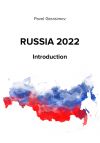Текст книги "Английский язык. Учебно-методическое пособие к практическим занятиям для биологов бакалавриата и магистратуры"

Автор книги: Шолпан Гумарова
Жанр: Зарубежная образовательная литература, Наука и Образование
сообщить о неприемлемом содержимом
Текущая страница: 1 (всего у книги 8 страниц) [доступный отрывок для чтения: 2 страниц]
Мулдагалиева А.А., Гумарова Ш.Б., Мадиева З.К.
Английский язык. Учебно – методическое пособие к практическим занятиям для биологов бакалавриата и магистратуры
SECTION I
UNIT I
New words and expressions:
protection – защита
pollution – загрязнение
environment – окружающая среда
exhaust fumes – выхлопные газы
source – источник
resourсеs – ресурсы
chemical substances – химические вещества
drainage – канализация, сток
purifier – очиститель
dump – свалка
disposal – расположение
sewage – сточные воды
calamity – бедствие
contamination – загрязнение, заражение
loss – потеря
species – виды
race – быстрое движение, путь
advancement – успех, прогресс
safeguard – гарантия, охрана, охранять
scatter – разбрасывать, рассеивать
distressing – огорчительный, внушающий беспокойство
irretrievable – непоправимый, невозместимый
Read the international words and give their Russian equivalents:
engineering, speculate, faculty, problem, ecology, civilization, industry, air, proportions, system, number, variety, expansion, urban, territory, asphalt, production, complexity, chemical, substances, combinations, role, resources, drainage, sphere, reason, reservoir, factory, era, national, ocean, seriously, figure, hectare, atmospheric, billion, ton, genetic, catastrophe, technological, investment, essential, protection, community, public.
MY SPECIALITY – APPLIED ECOLOGY
I am a student of the Faculty of Geography. My future speciality is applied ecology.
That the problem of pollution and ecology has become the most important one for mankind is evident to all. The more civilization is developing, the greater the ecological problems are becoming. Air, water and soil pollution by industry is now reaching tremendous proportions. It destroys the environment in big cities. Air is polluted mainly by heating systems and cars. You know how heavy the traffic is in big cities. The slower the traffic, the more exhaust fumes there are. The acuteness of the problem depends on how well the country is developed and on the number of cars.
The variety of polluting sources is growing. The expansion of urban territories with asphalt-covered roads, the increase in the production and the complexity of chemical substances and combinations used in everyday life have led to the ever increasing role in polluting water resources played by the drainage from the territory of cities, towns and villages. Such scattered sources of pollution cannot be enclosed in a pipe with a purifier mounted on its outlet.
The sphere of water pollution is broadening. During recent years a new problem appeared – the pollution of ground water. It is caused by a great variety of reasons: numerous waste dumps scattered all over the area and exposed to the influence of rainwater, polluted surface reservoirs, the disposal of sewage from factories (waste matter as well) and the use of water on oilfields.
In our era water pollution is changing from a national to an international problem, especially in territories where rivers cross several countries. The seas and oceans are also becoming seriously polluted.
The figures of the Earth's ecological calamities are distressing. Forests are disappearing at the rate of 20 hectares per minute, or more than 500 000 hectares a year. The volume of atmospheric oxygen annually decreases by 10 billion tons – a consequence of the destruction of forests and the contamination of water reservoirs.
The planet's genetic fund has sustained irretrievable losses: hundreds of species of animals, birds, fish and plants have disappeared forever. All these figures show our race to ecological catastrophe.
Our scientific knowledge and technological advancement make it possible to eliminate It, if people use good will and make considerable Investments for that purpose.
The essential feature of environmental protection is that many problems can be solved only at the level of world community. It is the joint efforts of many scientists and special public organizations that can deal with the problem and make necessary measures to protect the environment.
Joint actions of all countries can eliminate pollution and achieve successes in purifying air, water and soil and in safeguarding national resources.
EXERCISES:
I. Translate the following into English:
protect – protection, pollute – pollution, contaminate – contamination, purify – purifier – purification, environment – environmental, chemistry – chemist – chemical, source – resources, dispose – disposal, sewage – sewerage, lose – loss, eliminate – elimination, advance – advancement.
2. Find in the text the English equivalents for the following words and word-combinations:
проблема загрязнения окружающей среды, загрязнять, человечество, цивилизация, развиваться, дороги с асфальтовым покрытием, дождевая вода, сброшенная вода, исчезать, со скоростью, последствия разрушения, водохранилище, генофонд планеты, экологическая катастрофа, технический прогресс, устранить, сделать значительный вклад, основная черта, защита окружающей среды, разрешить проблему, на уровне мирового сообщества, совместные усилия, общественные организации, принять меры, очистка воздуха, охрана, выхлопные газы, свалка.
3. Open the brackets and use the proper tense:
1) The problem of pollution (become) the most important one for mankind,
2) Air, water and soil pollution (destroy) the environment.
3) The sphere of water pollution (broaden).
4) Water pollution (change) from a national to an international problem.
5) The planet's genetic fund (sustain) irretrievable losses.
4. Make questions of the following statements and then give short answers to each of them:
1) Hundreds of species of animals and plants have disappeared forever.
2) Our scientific knowledge and technological advancement make it possible to eliminate ecological catastrophe.
3) The essential feature of environmental protection is that many problems can be solved only at the level of world community.
4) Joint actions of all countries can eliminate pollution.
5) Air, water and soil pollution by industry is now reaching tremendous proportions.
6) Air is polluted mainly by heating systems and cars.
5. Answer the questions:
1) What is one of the most important problems for mankind now?
2) What is ecology? Give your definition.
3) What are the disadvantages of industrial development?
4) How does water, air, soil become polluted?
5) Why is the problem of water pollution becoming a global problem?
6) Why do the environmental problems require the cooperation of alt nations?
7) What makes it possible to eliminate air, water and soti pollution?
8) Why have you chosen the profession of an ecologist?
UNIT II
New words and expressions:
conservation – охрана природы
desiccation – высушивание
wildlife – живая природа
riverine – речной, прибрежный
pothole – пещера
bounty – щедрость
jeopardy – опасность
alteration – чередование
dam – плотина, преграждать
exacerbate – обострять
attempt – попытка, пытаться
clean-up – уборка, чистка
bird of prey – хищная птица
comprehensive – всесторонний
under way – на ходу
charge – нагрузка, заведовать
motivate – побуждать
desert – пустыня
Read the international words and give their Russin equivalents:
effect, nuclear, testing, range, population, flora, fauna, occupy, territory, peak, climate, zone, steppe, landscape, cultivating.
CLIMATE FOR CONSERVATION IN KAZAKHSTAN
Until recently, Kazakhstan has been better known for the harmful effects of the Semipalatinsk nuclear testing range and the desiccation of the Aral Sea than for its wildlife. In fact, the vast country supports rich and diverse population of flora and fauna. Kazakhstan occupies an enormous territory, extending from the Volga River on the West to the Altai Mountains on the East and from the Southern Urals and Western Siberia in the North to the snowy peaks of the Tien Shan Range and the deserts of Central Asia in the South. The country's climatic zones include everything from steppes, deserts and semideserts to mountain woodlands, riverine wetlands and pothole lakes. In this varied landscape can be found 104 species of amphibiance, 52 of reptiles, 488 of birds and 187 of mammals and nearly 5000 species of higher plants.
Now, however, this natural bounty is in jeopardy. Although Kazakhstan's population and its impact on the land are comparatively low; its biodiversity is seriously threatened in a number of ways. The alteration of the land that occured in the 1960's, when Khruschev ordered the country to begin cultivating corn on a mass scale, caused widespread damage. Rivers that fed steppe lakes were dammed and agricultural cultivation of the steppes, floodplains and marshes forced changes in natural ecosystems, exacerbated by the use of chemical pesticides, many already banned in the West. In addition, Kazakh industry generally does not employ any emission-control equipment or attempt cleanup of the environmental damage it causes. As a result, many natural species are now officially considered rare or endangered.
The country's economic crisis had led to a lessening of the human impact on natural ecosystems due to a decline in agriculture and industrial production. The situation could, however, take a rapid turn for the worse since the largely unregulated transition to a market economy has encouraged extensive commercil use of many plant and animal species including the export of natural products used for medicinal purposes such as antilope horn; the sale of rare insects in demand by collectors and the capture of birds of prey.
Unfortunately, no comprehensive natural conservation program exists at the present time. The isolated projects that are under way are targeted at regions of environmental crisis, such as the Aral Sea and the area around Semipalatinsk nuclear testing ground. Governmental structures charged with developing a national conservation strategy appear slow and unmotivated. The state, occupied with solving serious economic problems, cannot pay adequate attention to nature conservation.
In Kazakhstan no mass movement for nature protection exists as it does in western countries, but a few nongovernmental groups are beginning to form and take action. The activities of nongovermental organizations which are occuring in more and more cities around the country raise hopes for improvement of the nature conservation climate in Kazakhstan.
From «Surviving Together», T. Bragina, a scientist worker.
EXERCISES:
1. Translate the following into English:
motivate – motivation – unmotivated, occupy – occupation, serious – seriously, economy – economic – economics, attention – attentive – inattentive – attentively, nature – natural, conservation – conservative – conserve, protect – protection, form – formation, act – activity – action, organize – organization, hope – hopeful – hopeless – hopefulness.
2. Find in the text the English equivalents for the following words and word-combinations:
массовое движение, защита природы, западные страны, неправительственные организации, до недавнего времени, ядерные испытания, полигон, огромная территория, климатические зоны, полупустыня, пестициды, оборудование, рыночная экономика, в настоящее время, правительственные структуры, экономические проблемы.
3. Make questions of the following statements and then give short answers to each of them:
1) Kazakhstan occupies an enormous territory.
2) In this varied landscape a great number of species can be found.
3) Kazakhstan"s population is comparatively low.
4) Agricultural cultivation of the steppes forced changes in natural ecosystem.
5) Many natural species are now officially considered rare or endangered.
4. Answer the questions:
1) What species can be found in Kazakhstan?
2) What is the population of Kazakhstan?
3) What climatic zones of our country do you know?
4) What regions of environmental crisis in Kazakhstan are known to you?
5. Read the following sentences and point out the subject and the predicate in each of them:
1) Kazakhstan's biodiversity is seriously threatened.
2) The country's economic crisis had led to a lessening of human impact on natural ecosystems.
3) The largely unregulated transition to a market economy has encouraged extensive commercial use of many plant and animal species.
4) The projects are targeted at regions of environmental crisis.
5) A few nongovermental groups are beginning to take action.
UNIT III
New words and expressions:
salty – соленый
devastate – опустошать
trigger – вызывать
reverse – изменить
unfold – развертывать
basin – бассейн
shrink (shrunk) – садиться, вызывать усадку
irrigation – орошение
reduce – уменьшать
inflow – приток
evaporation – испарение
precipitation – выпадение осадков
estimate – оценивать
encompass – окружать
flow – течение
arise – возникать
saline – соляной
fishery – рыбный промысел
diversity – разнообразие
husbandry – сельское хозяйство
reed – камыш
diminuation – уменьшение
discharge – выделение
expand – расширять
recession – спад
gain – прибыль, прирост
loss – потеря, ущерб
prevent – предупреждать, мешать
surface – поверхность
shallow – мелкий
extend – простираться
drainage – сток
net – сеть, чистый
Read the international words and give their Russian equivalents:
major, history, effect, million, transport, hydrogeological, engineer, decade, problem, planet, serious, tragedy, national, central, fundamentally, balance, natural, hectar, canal, application, reservoir, filtration, system, result, accelerate, block, separate, western, portion, stabilize, kilometer
THE ARAL SEA PROBLEM
There are two major environmental disasters in the recent history of the former Soviet Union: Chernobyl and the Aral Sea. In 1960 the land-locked Aral Sea was the world's fourth largest lake, but now, due to increased irrigation demands on its two main inflowing rivers, it is now half the size, 16 m lower and three times as salty. The effect on the 3 mln people who needed the lake for its water, fish and transport has been slowly devastating. Sadly, the huge hydrogeological changes which engineers have unwittingly triggered will take decades to reverse. This paper investigates the nature, causes and consequences of the Aral Sea problem and discusses proposed solutions.
One of the planet's most serious environmental and human tragedies is unfolding in the basin of the Aral Sea. Over the past 40 years, the huge lake has shrunk considerably as expanding irrigation has reduced river inflow to it.
The Aral Sea and its Water Balance
The Aral Sea is located among the deserts of Central Asia. A terminal lake (i.e., without surface inflow ), its level is fundamentally determined by the balance between surface inflow from two large rivers and net evaporation ( i. e. evaporation from its surface minus precipitation on it), which is estimated to be around 874 mm per year. Net ground water exchange plays a secondary role and data on it are approximate.
Five former republics, now independent nations, lie wholly or partially in the sea's basin: Uzbekistan, Kazakstan, Kyrgyzstan, Turkmenistan and Tadzhikistan. The Aral Sea drainage basin encompasses all of Uzbekistan and Tadzhikistan, all but the nothern part of Kyrgyzstan, the eastern half of Turkmenia and the two southern oblasts of Kazakstan. It also includes part of nothern Iran and Afganistan. The flow of the Amu-Dar'ya arises primarily from the Pamir Mountains and the flow of the Syr-Dar'ya primarily from the Tien-Shan Mountains. The population of that part of the Aral Sea basin lying in the former Soviet Union was around 35 mln in 1990.
The Aral Sea was the world's fourth largest lake in the area in 1960. Although somewhat saline the lake was populated mainly by fresh water species and had a productive fishery as well as serving as a major regional transportation route. The vast deltas of Amu-Dar'ya and Syr-Dar'ya not only had major ecological significance, with a diversity of floral and faunal species but great economic importance related to irrigated agriculture and animal husbandry, hunting and trapping, fishing and harvesting of the reeds that grow in abundance in the numerous wetlands and lakes found here.
Over the past 40 years the sea has steadily shrunk. The reason is a huge and growing diminuation of discharge from the Amu-Dar'ya and Syr-Dar'ya, caused primarily by the expanding irrigation in their basins.
Irrigation expantion in the Aral Sea basin after 1960 required much more water per hectar as long canals were extended into the desert; poorer, more saline soils were irrigated, requiring heavier water applications. Giant reservoirs were built that required filling and which increased evaporative losses, and new irrigation systems discharged their water into the deserts rather than back to the rivers.
The net result has been an increasingly large difference between the gain (river inflow) and loss (net evaporation) sides of the sea's water balance. Consequently, the drying, recession and salingation that began in 1960s, accelerated in the 1970s and 1980s and continues into 1990s.
In 1987 the Aral Sea divided into two water bodies: the smaller sea in the north and the larger one in the south. Since then, these have developed as separate water bodies with their own water balances. The Syr-Dar'ya flows into the small sea, whereas the Amu-Dar'ya enters the large sea. A connecting channel existed between the two until mid 1992 when it was blocked by a dike to prevent further water loss from the small to the large sea.
The water body will continue to shrink rapidly because net inflow to it, consisting of surface and subsurface compounds, will remain well below net evaporation. By 2005, when the level falls to 30 m the large sea will separate into a deep western part, which would continue to recede and salinize since it would receive no surface inflow, and a shallow eastern portion which would shrink and salinize less rapidly since it would continue to receive inflow from the Amu-Dar'ya. The eastern part of the large sea would stabilize with an area around 7000 sq km later in the century.
EXERCISES:
1. Translate the following into English:
recede – recession, environment – environmental, serious – seriously, exist – existence – existent – existing, reduce – reduction, fundamental – fundamentally, nature – natural, expand – expansion, extend – extension – extensive – extent, flow – inflow, salty – salt – saline – salinize – salingation– salinity, fish – fishery – fishing, charge – discharge, diminuation – minimum – minimal – minimize, evaporate – evaporation – evaporative, increase – encreasingly, separate – separation, rapid – rapidly, irrigate – irrigation
2. Find in the text the English equivalents for the following words and word-combinations:
огромные гидрогеологические изменения, орошение, требование, впадающие реки, десятилетия, исследовать, последствия, проблема Аральского моря, предложенные решения, пустыни Центральной Азии, уровень, определять, испарение, выпадение осадков, оценивать, второстепенная роль, приблизительные данные, независимые государства, целиком, частично, бассейн Аральского моря, кроме северной части, включать, население, четвертое по величине озеро в мире, рыбный промысел, обширная дельта, разнообразие флоры и фауны, важное экономическое значение, расти в изобилии, многочисленный, за последние 40 лет, пустыня, разделять, с тех пор, насыпь, оставаться.
3. Make questions of the following statements and then give short answers to each of them:
1. The land-locked Aral Sea was the world's fourth largest lake.
2. The Aral Sea is now half the size.
3. The huge lake has shrunk considerably.
4. Expanding irrigation has reduced river inflow to the Aral Sea.
5. The Aral Sea is located among the deserts of Central Asia.
6. Data on net ground water exchange are approximate.
7. Five independent nations lie in the sea's basin.
8. The population of that part of the Aral Sea basin was around 35 mln.
9. The lake was populated mainly by fresh water species.
10. Reeds grow in abundance in the numerous wetlands and lakes.
4. Find in the text the passages to which the questions refer:
1. Why has the Aral Sea shrunk considerably?
2. Where is the Aral Sea located?
3. Why did the drying, recession and salingation of the Aral Sea accelerate in the 1970-1980s?
4. What part of the Aral Sea will stabilize by 2005?
5. Read the following sentences and point out the subject and the predicate in each of them:
1. This paper investigates the nature, causes and consequences of the Aral Sea problem.
2. One of the planet's most serious environmental and human tragedies is unfolding in the basin of the Aral Sea.
3. Expanding irrigation has reduced river inflow to the Aral Sea.
The Aral Sea had a productive fishery and served as a major transportation route.
4. Irrigation expansion in the Aral Sea basin after 1960 required much more water per hectar.
5. The Aral Sea is divided into two water bodies.
Правообладателям!
Данное произведение размещено по согласованию с ООО "ЛитРес" (20% исходного текста). Если размещение книги нарушает чьи-либо права, то сообщите об этом.Читателям!
Оплатили, но не знаете что делать дальше?








































